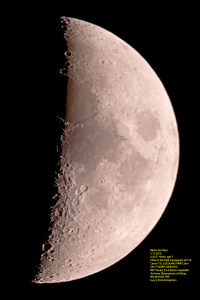The Junior Astronomer has now earned the title Junior Astrophotographer.

First, let me say that this photo took a long time to process, because somehow my lunar processing mojo went out the window when I switched to Observatory 2.1. My apologies to Junior for that — it took a full month between shooting the photo and posting it.
With that out of the way, here’s the story.
The Junior Astronomer has been really learning the ropes out in the shed. During this latest round of clear sky, she has started really learning all the different bits that need to come together to take photos.
So, on this night, after I unlocked the front door, she went up to the observing deck, opened the shutter, rotated the dome, found her target in the finderscope, and plugged in and powered up the mount. Her upstairs work complete, she proceeded down to Telescope Control, booted telescope control machine, booted the console machine, and used VNC to remote across.
She started the chart software, connecting and synching the mount. She connected to the dome, and synched it with the mount. We decided together not to start the guide software, as we were “only” shooting the moon. Then she started up the image sequencer, connected to the camera, set up the exposure lengths, and fired a test image.
It was at this point that she realized that the camera needed to be rotated; Cassie produces such a large image of the moon that it spills off the top and bottom of the frame, but we took advantage of the “skinny” lunar phase, and were able to squeeze it in. She did all of that, heading back upstairs to rotate the camera, using the viewfinder to make sure she was lined up properly. The moon covered about 60% of the entire frame — it will be gorgeous when printed at full 18mpx resolution.
She took another test photo, to confirm that she was happy with the orientation, and proceeded to roll off about 50 frames of the moon.
The evening was a great success, and she’s super proud of the job she did.
I intended to have her do all the post-processing, too, but I think I’ll have her do that to her deep sky or planetary photos, because the moon procedure is quite complicated, but for posterity, this is what I did:
1) move RAW images to OSX
2) Adobe Bridge to convert RAW to TIF (and initial color balance)
3) move TIF images to Windows
4) PIPP to sort images by quality and choose best 50%
5) Registax 5 (not 6), manually align images (must find a better way to do this!), and stack into single, final photo
6) move image back to OSX
7) Photoshop CC for derotation, Levels, Curves, image sizing and cropping, and labeling.
All that moving from one OS to the other is a real drag, but I don’t (apparently) have a stacking solution in OSX that will work, because Nebulosity 4 completely failed to get the job done. Honestly, I thrashed between Registax (5 and 6) and AutoStakkert!2 quite a bit, too, and nothing produced a properly correct image, but this is what I got. Can you tell I’m a little frustrated?
I used to use MaxIM DL to stack all DSLR photos, and it somehow did a better job of “just dealing with it” and getting a lunar stack. So far, nothing else seems to be able to deal with the big DSLR photos and a non-stellar target (at the same time).
The Junior Astrophotographer is understandably proud of her achievement, and I look forward to many more great nights of photography with her, under the stars!

MOST COMMENTED
Observatory
Observatory 2.0 – Time has come today!
General / Maintenance
First Light, a deeper look
Mount / Observatory / Telescope
Observatory 2.0 – Result!
Observatory
Observatory 2.0 – The Pier goes in
Gear / General / Maintenance
Martin Farmer Wormblock installation notes
Deep Sky / Long Exposure Photography
NGC2244, The Rosette Nebula
Deep Sky / Long Exposure Photography
Another beautiful night.